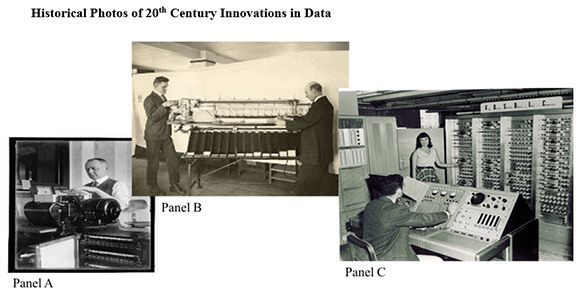Improving Household Statistics Through Data Innovation
Improving Household Statistics Through Data Innovation
Ever wonder how the U.S. Census Bureau uses innovation to spark enhanced statistical measures and reporting of household statistics? In the last century, innovation at the Census Bureau took place in the form of improvements made to fielding surveys or processing data. The pictures below highlight technological innovation in the 20th century — tabulating machines, punch card readers, and advances like the Film Optical Sensing Device for Input to Computer (FOSDIC) machine, which read survey responses much as we process standardized tests. These innovations led to increased efficiencies and decreased costs associated with data collection and processing.

Panel A: Tabulating Machine (1910). Panel B: Punch Card Sorter (1920). Panel C: Film Optical Sensing Device for Input to Computer (FOSDIC) machine (1960)
The turn of the 21st century led to increased innovation in data collection and recent technological advancements including alternative methods of data collection, such as testing web functionality for survey response. Innovation at the Census Bureau, however, is not limited to innovation in data collection and processing.
Today, more than ever, the Census Bureau focuses on using big data like administrative records to make improvements to official household statistics. Ultimately, the key to innovation in this space is understanding how to best harness already existing big data to improve official estimates of poverty, income inequality, and other important statistics. The Census Bureau is embarking on multiple projects that focus on procuring, harmonizing, and linking data in unique ways in an effort to advance improvements of national household statistics.
For instance, we are leading a new effort using administrative records to study the feasibility of incorporating them to produce more precise estimates of the Supplemental Poverty Measure.
An example of our work is highlighted this week at the Population Association of America’s Annual Meeting in Chicago, Ill., from April 27-29, 2017. We use administrative records on the Supplemental Nutrition Assistance Program (SNAP, formerly Food Stamps) from the state of Maryland to evaluate differences in self-reported SNAP participation in survey response versus the assistance program’s administrative records. Overall, we find that there is underreporting of the program take-up in household surveys like the Current Population Survey. This underreporting leads to a slightly inflated estimate of the Supplemental Poverty Measure by about 0.3 percentage points for the state of Maryland (results not shown). For married couple units, there is a 0.1 percentage point difference and for female householder units a 0.8 percentage point difference (as shown below).
Source: Current Population Survey, Pooled 2009-2012, linked to the Supplemental Nutrition Assistance Program administrative records for the same years.
Notes: * Indicates change is statistically different from zero at the 90 percent confidence level. † Administrative records are those records collected by the state for the main purpose of administering the program.
For the Supplemental Poverty Measure, the family unit includes all related individuals who live at the same address, as well as any co-resident, unrelated children who are cared for by the family (such as foster children), and any unmarried partners and their children. A “New Supplemental Poverty Measure unit” is a family unit that added at least one new member, such as an unmarried partner or foster child.
In other work, we are studying differences in the black-white earnings gap when using self-reported income from surveys compared to tax administrative records. The figure below shows the black-white earnings ratio with confidence intervals for working men. In most years, the earnings gap calculated using survey data is reportedly smaller between black and white men than when estimated using administrative earnings records. For example, in 2006 the gap between black and white male earnings was $0.34 using self-reported earnings from the Current Population Survey and $0.41 using administrative earnings records. While further research is required, preliminary results indicate that data source might matter for measuring income inequality, and reported earnings in the Current Population Survey potentially masks the magnitude of inequality.
Source: Current Population Survey, 2006-2014, linked to the Detailed Earnings Record (DER) for the relevant reference years (2005-2013).
Notes: Earnings ratio is the difference between the black and white population in terms of earnings. For example, according to the Current Population Survey in 2013, black men working full time, year-round and ages 25 to 64 earned $0.67 compared to every $1.00 earned by similarly situated white men. Shown are 90 percent confidence intervals computed using replicate weights.
These efforts are not in isolation. We are also leading a large, new innovation project at the Census Bureau where we are generating master demographic files that link together core demographic information on individuals surveyed by the Census Bureau, while maintaining confidentiality regardless of the specific survey. Master demographic files can then be used to inform other federal agencies, and lead demographic evaluations and research about individuals funded through federal programs.
These efforts are just a handful of examples of some of the exciting, innovative data measurement efforts happening at the Census Bureau. The timing is relevant. In this day and age, there is both a strong push and pull to use and rely on quality statistics, research and evaluation to inform policy decision-making. The Federal Commission for Evidence-Based Policymaking is leading national efforts to examine how federal agencies can use and innovate data to inform our leaders and decision-makers. We at the Census Bureau take that charge seriously. Linking big data and administrative records to household surveys in unique ways to help us create more precise and accurate national statistics is a top priority.
For more information, see my poster and please join us at the 2017 Population Association of America conference.
-X-





